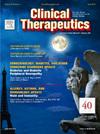2019年冠状病毒病康复患者总免疫球蛋白G (IgG)及其亚类随时间的分析及其与疾病严重程度的关系:一项单中心前瞻性队列研究
IF 3.6
4区 医学
Q2 PHARMACOLOGY & PHARMACY
引用次数: 0
摘要
目的:为了解决抗体水平随时间推移而降低以及轻、重度病例之间反应差异的问题,正在努力确定2019冠状病毒病(COVID-19)患者体内免疫球蛋白G (IgG)抗体持续存在的时间。方法:本研究对37例未接种疫苗的covid -19康复患者进行了为期6个月的纵向研究。在COVID-19恢复后3个时间点(≤1个月、1-3个月和3-6个月)检测血清中刺突蛋白和受体结合域(RBD)特异性IgG和IgG亚类水平。结果:我们的研究发现,在COVID-19感染恢复后的3至6个月内,抗尖峰抗体和抗rbd抗体水平显著(P < 0.05)降低。重症患者组的抗尖峰抗体和抗rbd IgG水平高于轻症患者组。在covid -19康复患者中,IgG1和IgG3的贡献随时间的变化有统计学意义,表明IgG亚类的分布可能发生变化。严重急性呼吸综合征冠状病毒2型感染患者在康复后1 ~ 3个月内血清IgG1水平比轻症患者高1.5倍。意义:本研究发现,未接种疫苗的重症COVID-19患者抗体滴度更高,感染后抗刺突抗体持续存在的可能性更大。IgG1和IgG3的水平随着COVID-19的严重程度而显著升高,表明在更严重的病例中免疫反应增强。血清IgG亚类水平的估计可能决定疫苗接种策略和治疗过程。本文章由计算机程序翻译,如有差异,请以英文原文为准。
Analysis of the Total Immunoglobulin G (IgG) and Its Subclasses Over Time in Coronavirus Disease 2019–Recovered Patients and Its Association With Disease Severity: A Single-Center Prospective Cohort Study
Purpose
In order to address concerns regarding the diminishing levels of antibodies over time and the variations in response between mild and severe cases, efforts are being made to determine how long immunoglobulin G (IgG) antibodies persist in patients with coronavirus disease 2019 (COVID-19).
Methods
The present study was conducted in a longitudinal setting over a period of 6 months in 37 unvaccinated COVID-19–recovered patients. The spike protein and receptor-binding domain (RBD)–specific serum levels of IgG and IgG subclasses were measured at 3 time points (within ≤1 month, 1–3 months, and 3–6 months) of recovery from COVID-19.
Findings
Our study found a significant (P < 0.05) reduction in the levels of antispike and anti-RBD antibodies within 3 to 6 months after recovery from COVID-19 infections. The group of patients who developed severe illness had higher levels of antispike and anti-RBD IgG compared with the group of patients who recovered from mild disease. There was a statistically significant difference in the contribution of IgG1 and IgG3 over time in COVID-19-recovered patients, indicating a potential alteration in the distribution of IgG subclasses. Serum levels of IgG1 were found to be 1.5 folds higher within 1 to 3 months of recovery from severe acute respiratory syndrome coronavirus 2 infections in severe cases than mild cases.
Implications
This study found that severe COVID-19 cases in unvaccinated patients had higher antibody titers and a greater likelihood of antispike antibodies persisting after infection. The levels of IgG1 and IgG3 increased significantly with the severity of COVID-19, indicating a heightened immune response in more severe cases. The estimation of serum levels of IgG subclass may determine the vaccination strategy and the process of treatment.
求助全文
通过发布文献求助,成功后即可免费获取论文全文。
去求助
来源期刊

Clinical therapeutics
医学-药学
CiteScore
6.00
自引率
3.10%
发文量
154
审稿时长
9 weeks
期刊介绍:
Clinical Therapeutics provides peer-reviewed, rapid publication of recent developments in drug and other therapies as well as in diagnostics, pharmacoeconomics, health policy, treatment outcomes, and innovations in drug and biologics research. In addition Clinical Therapeutics features updates on specific topics collated by expert Topic Editors. Clinical Therapeutics is read by a large international audience of scientists and clinicians in a variety of research, academic, and clinical practice settings. Articles are indexed by all major biomedical abstracting databases.
 求助内容:
求助内容: 应助结果提醒方式:
应助结果提醒方式:


